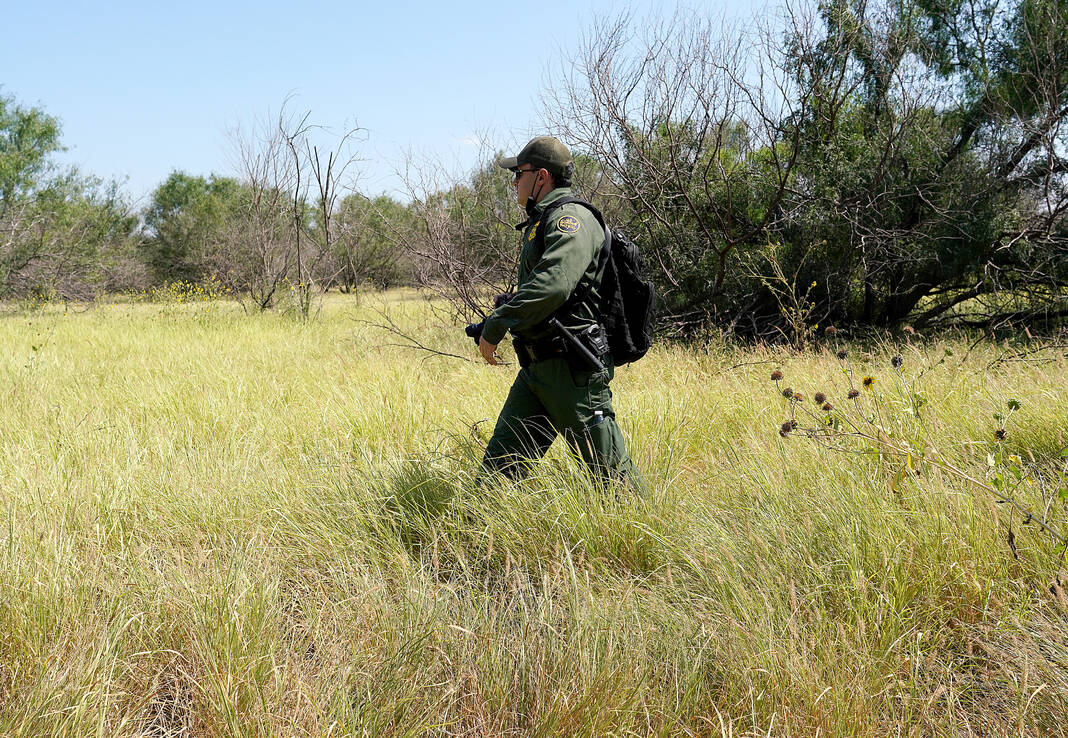MISSION — As temperatures rose dangerously close to triple-digit territory, Rio Grande Valley Border Patrol agents rushed through brush on Tuesday, chasing their K-9 unit in search of a 16-year-old girl who had been separated from her mother.
They found her about 10 minutes after her mother called for help.
A K-9 unit managed to find the girl in a delirious state, but still alive. Agents placed her on a stretcher and carried her for what felt like over a mile to the closest landing zone where a helicopter waited to take her to safety.
And although Tuesday’s scenario was a simulation by RGV Border Patrol agents, the temperatures, environments and situations they face on an almost daily basis are a very real occurrence.
“We’ve asked you to be here today to bring awareness to the dangers migrants face every day when they decide to make the perilous journey into the United States,” Deputy Chief Patrol Agent Joel Martinez said.
The event was created to offer a first-hand look at the enforcement and humanitarian missions agents carry out near the Anzalduas Park in Mission, though a majority of the demonstration was further south from the park.
The event came a day after 51 migrants died trapped in a tractor trailer near San Antonio, some of which are suspected to be minors.
Though the incident was addressed at the event a handful of times, Special Operations Supervisor Christian Alvarez made it clear their sector had no information on the matter, but did share statistics regarding the RGV region.
According to Martinez, there have been over 140 deaths in the RGV Sector this year alone, in comparison to 120 last year.
“Since October, our agents have performed over 913 rescues surpassing last fiscal years’ of 677, and we still have three months to go,” Martinez said.
Martinez said there’s about 47 rescue beacons scattered across the RGV in strategic places for people in dire need to use, one of which was used in Tuesday’s simulation.
“[Once a] rescue beacon is activated [it] sends a signal over to our dispatch … the operator relays that information and dispatches the agent,” Assistant Chief Patrol Agent
Milton Moreno said.
Moreno added that the beacon is equipped with a microphone and camera so the operator is able to see what’s happening and communicate with the person in need of assistance.
According to Martinez, the RGV has had an increase of 440% in beacon initiated rescues.
Martinez added that there’s over a thousand rescue placards distributed throughout the region in remote areas and they’re deploying 650 water rescue placards this fiscal year.
Agents also showed the all-terrain vehicles and drones they use in order to search and rescue someone who may be lost in the wilderness.
Agents also showed an aquatic rescue, with an agent helping a person struggling to swim in a body of water.
“And that’s because he knew how to swim,” Agent Jesse Moreno, who’s forehead dripped with sweat, said as he winded the rope he used to pull in the scenario’s drowning actor. “Usually, it’s not just one person who needs rescuing.”
The agents continuously emphasized the dangers of traversing the South Texas region through the entirety of the event, asking everyone involved to stay hydrated and to be aware of the wildlife as well as the terrain.
Martinez says the best way to avoid more deaths and to keep everyone safe is to simply not take the risk of crossing the border, especially when involving criminal organizations to help smuggle someone across.
“Our message is clear; it’s not worth it,” Martinez said. “Do not place your life or lives of your loved ones in the hands of these criminals. People must understand the gravity and dangers of dealing with smugglers and the cartels that employ them.
“Unfortunately, yesterday we saw a cruel example of the realities these desperate human beings face as they place their lives in the hands of criminals who could care less about what happens to them as their commodity.”





